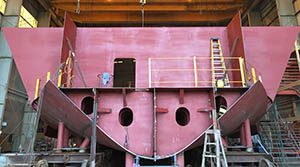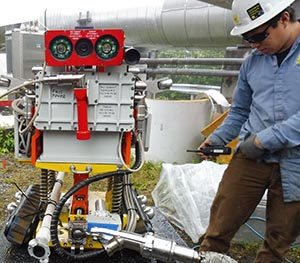On September 26, I visited with our team in Valdez, where almost 300 individuals stepped up to respond to a terminal spill that occurred near Berth 5 on September 21. Responders included Alyeska’s Ship Escort/Response Vessel System (SERVS) staff, other Alyeska and contractor personnel, vessels and crews from the Vessel of Opportunity program, U.S. Coast Guard and Alaska Department of Environmental Conservation agency personnel, and representatives from the Prince William Sound Regional Citizens’ Advisory Council.
Alyeska Column
From Alyeska: Alyeska staff find creative solutions for safe snow removal
Submitted by Alyeska Corporate Communications.
 While spring officially arrived in March, the snow keeps falling in Valdez, the snowiest city in America. The white stuff has long stymied crews at the Valdez Marine Terminal, who often spend weeks clearing snow from areas around the 1,000-acre facility, including crude oil storage tank roofs. It wasn’t always that way.
While spring officially arrived in March, the snow keeps falling in Valdez, the snowiest city in America. The white stuff has long stymied crews at the Valdez Marine Terminal, who often spend weeks clearing snow from areas around the 1,000-acre facility, including crude oil storage tank roofs. It wasn’t always that way.
“When I started here in the mid-nineties, all we had to do was move oil from tank to tank,” said Al Laudert, a Terminal Maintenance Coordinator. “The oil was so warm, enough of it in the tank would make the snow shed right off the top.”
But with declining throughput, the crude oil leaves the North Slope cooler, takes longer to arrive in Valdez, and isn’t warm enough to melt the snow of the tops of the storage tanks. Alyeska has always had a busy snow removal program, but has had to bring in crews for the tank farms since the early 2000s.
The tank top snow removal crews are made up of 7-10 people who can take up to a week to clear off one tank. This shoveling job is quite a bit bigger than your driveway; the roofs are about an acre in area and more than 60 feet off the ground.
From Alyeska: Alyeska’s commitments during transition include protection, safe oil transportation, and transparency
Mike Day, Operations Manager for Alyeska’s Ship Escort/Response Vessel System.

My name is Mike Day and I’m the accountable manager for the marine services transition, which means that I oversee the internal Alyeska transition team and work with Edison Chouest Offshore, or ECO, to make sure they’re ready to provide services in Prince William Sound in 2018. As a lifelong resident of Prince William Sound, it’s incredibly important to me that we are successful.
I recently spent a few days at ECO facilities to monitor the work. ECO is building nine new tugs for Alyeska, and construction is progressing on schedule. They will be built at Edison Chouest shipyards in Louisiana and Mississippi, before completing extensive sea trials in the Gulf of Mexico or Puget Sound, and additional tests in Prince William Sound.
From Alyeska: Pipe inspections on terminal finds no repairs needed
Submitted by Alyeska Corporate Communications.

This summer, Alyeska’s multi-year internal inspection program of Valdez Marine Terminal piping included inspecting buried relief system and crude oil piping in and around the East Metering building, and from West Metering to the end of Berth 5. Much of this piping is encased in concrete and was considered “uninspectable” until recent advances in inspection technology.
Crews started in the spring, working in and around the East Metering building where oil enters the Terminal and is measured as part of the pipeline leak detection system. They built containment and installed equipment to allow for system isolation. The roof was modified so cranes could remove large segments of pipe from the building and return them after the inspection.
During a scheduled maintenance shutdown in June, TAPS personnel drained down and isolated the impacted piping around East Metering. Once the shutdown was completed, a contractor cleaned the pipe with special equipment that limited physical entry into the pipe. Crews removed several 90-degree pipe segments to create access points for the crawler pig (see photos) that carries the inspection tool through the pipe. Pigs inspected approximately 2,100 feet of pipe ranging from 16 to 36 inches in diameter.
Alyeska integrity management staff analyzed the data, and found no needed repairs and no significant impact to pipeline or Terminal operations. The piping has returned to service.